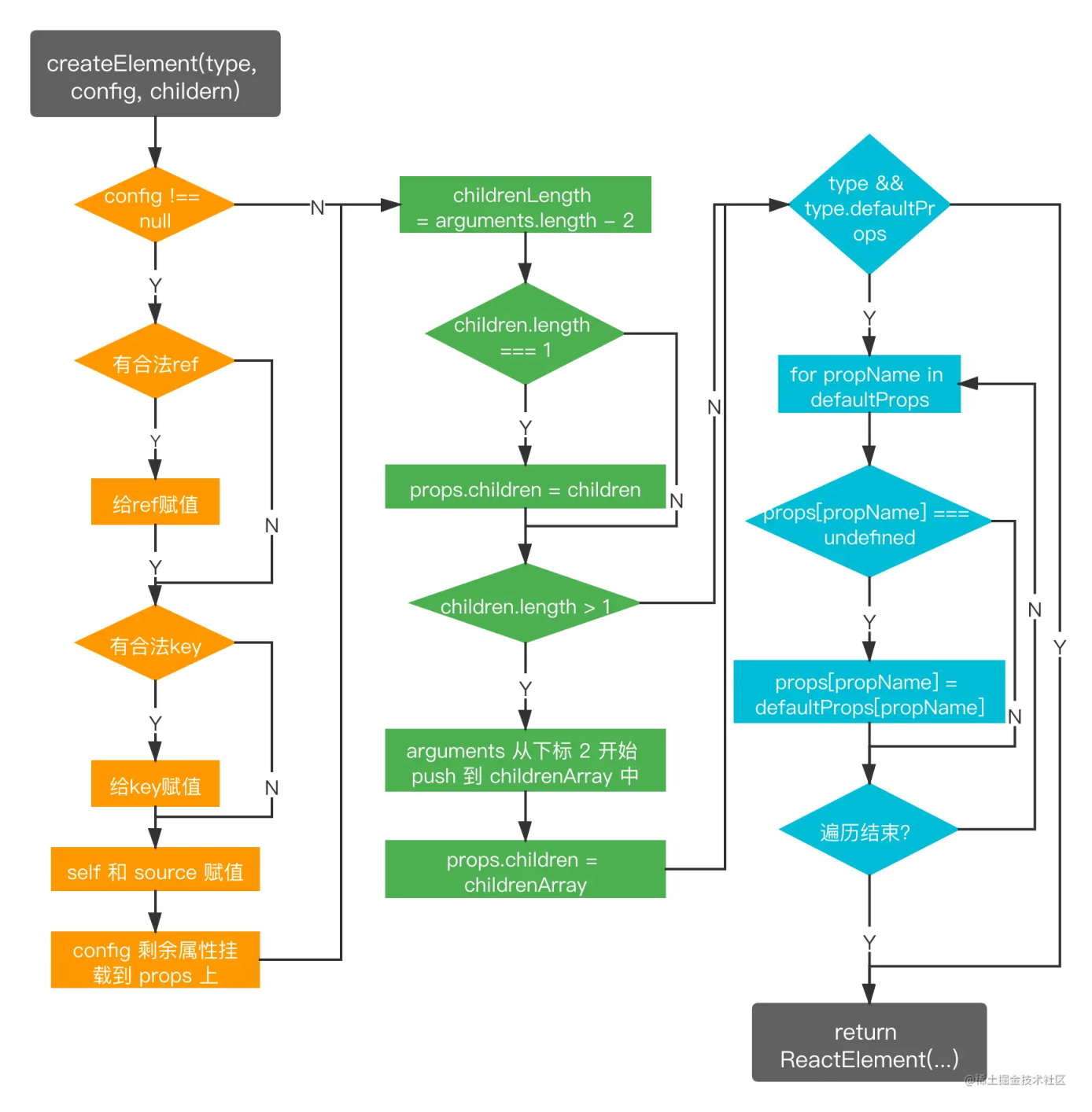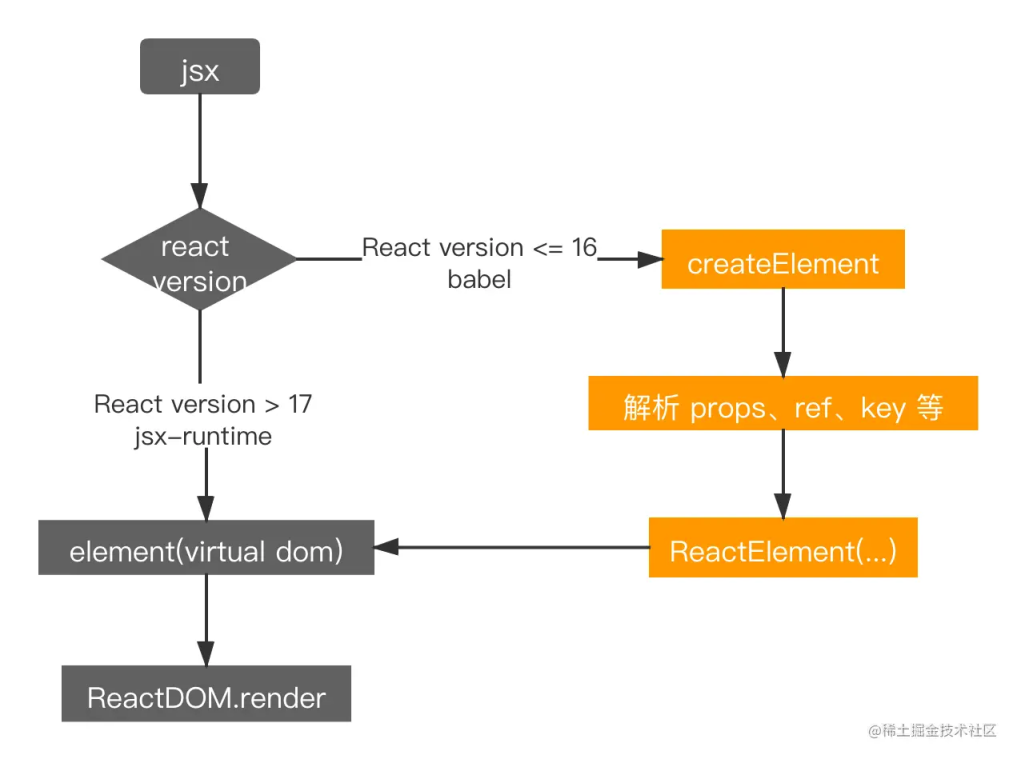jsx 的转换
我们从 react 应用的入口开始对源码进行分析,创建一个简单的 hello, world 应用:
import React, { Component } from 'react';import ReactDOM from 'react-dom';export default class App extends Component { render() { return <div>hello, world</div>; }}
ReactDOM.render(<App />, document.getElementById('root'));
复制代码
我们注意到,我们在 App 组件中直接写了 return <div>hello, world</div> 的 jsx 语句,那么 jsx 语法是如何被浏览器识别执行的呢?
另外我在第一次学习 react 的时候,就有一个疑惑: import React, { Component } from 'react' 这段代码中,React 似乎在代码中没有任何地方被用到,为什么要引入呢?
16.x 版本及之前
我们在 react16.8 版本的代码中,尝试将 React 的引用去掉:
// import React, { Component } from 'react';import { Component } from 'react'; // 去掉 React 的引用import ReactDOM from 'react-dom';
export default class App extends Component { render() { return <div>hello, world</div>; }}
ReactDOM.render(<App />, document.getElementById('root'));
复制代码
运行应用程序,发现会提示 'React' must be in scope when using JSX 的 error:
这是因为上述的类组件 render 中返回了 <div>hello, world</div> 的 jsx 语法,在 React16 版本及之前,应用程序通过 @babel/preset-react 将 jsx 语法转换为 React.createElement 的 js 代码,因此需要显式将 React 引入,才能正常调用 createElement。我们可以在 Babel REPL 中看到 jsx 被 @babel/preset-react 编译后的结果
17.x 版本及之后
React17 版本之后,官方与 bbel 进行了合作,直接通过将 react/jsx-runtime 对 jsx 语法进行了新的转换而不依赖 React.createElement,转换的结果便是可直接供 ReactDOM.render 使用的 ReactElement 对象。因此如果在 React17 版本后只是用 jsx 语法不使用其他的 react 提供的 api,可以不引入 React,应用程序依然能够正常运行。
更多有关于 React jsx 转换的内容可以去看官网了解:介绍全新的 JSX 转换,在这里就不再过多展开了。
React.createElement 源码
虽然现在 react17 之后我们可以不再依赖 React.createElement 这个 api 了,但是实际场景中以及很多开源包中可能会有很多通过 React.createElement 手动创建元素的场景,所以还是推荐学习一下 React.createElement 源码。
React.createElement 其接收三个或以上参数:
type:要创建的 React 元素类型,可以是标签名称字符串,如 'div' 或者 'span' 等;也可以是 React 组件 类型(class 组件或者函数组件);或者是 React fragment 类型。
config:写在标签上的属性的集合,js 对象格式,若标签上未添加任何属性则为 null。
children:从第三个参数开始后的参数为当前创建的 React 元素的子节点,每个参数的类型,若是当前元素节点的 textContent 则为字符串类型;否则为新的 React.createElement 创建的元素。
函数中会对参数进行一系列的解析,源码如下,对源码相关的理解都用注释进行了标记:
export function createElement(type, config, children) { let propName;
// 记录标签上的属性集合 const props = {};
let key = null; let ref = null; let self = null; let source = null;
// config 不为 null 时,说明标签上有属性,将属性添加到 props 中 // 其中,key 和 ref 为 react 提供的特殊属性,不加入到 props 中,而是用 key 和 ref 单独记录 if (config != null) { if (hasValidRef(config)) { // 有合法的 ref 时,则给 ref 赋值 ref = config.ref;
if (__DEV__) { warnIfStringRefCannotBeAutoConverted(config); } } if (hasValidKey(config)) { // 有合法的 key 时,则给 key 赋值 key = '' + config.key; }
// self 和 source 是开发环境下对代码在编译器中位置等信息进行记录,用于开发环境下调试 self = config.__self === undefined ? null : config.__self; source = config.__source === undefined ? null : config.__source; // 将 config 中除 key、ref、__self、__source 之外的属性添加到 props 中 for (propName in config) { if ( hasOwnProperty.call(config, propName) && !RESERVED_PROPS.hasOwnProperty(propName) ) { props[propName] = config[propName]; } } }
// 将子节点添加到 props 的 children 属性上 const childrenLength = arguments.length - 2; if (childrenLength === 1) { // 共 3 个参数时表示只有一个子节点,直接将子节点赋值给 props 的 children 属性 props.children = children; } else if (childrenLength > 1) { // 3 个以上参数时表示有多个子节点,将子节点 push 到一个数组中然后将数组赋值给 props 的 children const childArray = Array(childrenLength); for (let i = 0; i < childrenLength; i++) { childArray[i] = arguments[i + 2]; } // 开发环境下冻结 childArray,防止被随意修改 if (__DEV__) { if (Object.freeze) { Object.freeze(childArray); } } props.children = childArray; }
// 如果有 defaultProps,对其遍历并且将用户在标签上未对其手动设置属性添加进 props 中 // 此处针对 class 组件类型 if (type && type.defaultProps) { const defaultProps = type.defaultProps; for (propName in defaultProps) { if (props[propName] === undefined) { props[propName] = defaultProps[propName]; } } }
// key 和 ref 不挂载到 props 上 // 开发环境下若想通过 props.key 或者 props.ref 获取则 warning if (__DEV__) { if (key || ref) { const displayName = typeof type === 'function' ? type.displayName || type.name || 'Unknown' : type; if (key) { defineKeyPropWarningGetter(props, displayName); } if (ref) { defineRefPropWarningGetter(props, displayName); } } }
// 调用 ReactElement 并返回 return ReactElement( type, key, ref, self, source, ReactCurrentOwner.current, props, );}
复制代码
相关参考视频讲解:进入学习
由代码可知,React.createElement 做的事情主要有:
解析 config 参数中是否有合法的 key、ref、__source 和 __self 属性,若存在分别赋值给 key、ref、source 和 self;将剩余的属性解析挂载到 props 上
除 type 和 config 外后面的参数,挂载到 props.children 上
针对类组件,如果 type.defaultProps 存在,遍历 type.defaultProps 的属性,如果 props 不存在该属性,则添加到 props 上
将 type、key、ref、self、props 等信息,调用 ReactElement 函数创建虚拟 dom,ReactElement 主要是在开发环境下通过 Object.defineProperty 将 _store、_self、_source 设置为不可枚举,提高 element 比较时的性能:
所以通过流程图总结一下 createElement 所做的事情如下:
React.Component 源码
我们回到上述 hello,world 应用程序代码中,创建类组件时,我们继承了从 react 库中引入的 Component,我们再看一下 React.Component 源码:
function Component(props, context, updater) { // 接收 props,context,updater 进行初始化,挂载到 this 上 this.props = props; this.context = context; this.refs = emptyObject; // updater 上挂载了 isMounted、enqueueForceUpdate、enqueueSetState 等触发器方法 this.updater = updater || ReactNoopUpdateQueue;}
// 原型链上挂载 isReactComponent,在 ReactDOM.render 时用于和函数组件做区分Component.prototype.isReactComponent = {};
// 给类组件添加 `this.setState` 方法Component.prototype.setState = function(partialState, callback) { // 验证参数是否合法 invariant( typeof partialState === 'object' || typeof partialState === 'function' || partialState == null ); // 添加至 enqueueSetState 队列 this.updater.enqueueSetState(this, partialState, callback, 'setState');};
// 给类组件添加 `this.forceUpdate` 方法Component.prototype.forceUpdate = function(callback) { // 添加至 enqueueForceUpdate 队列 this.updater.enqueueForceUpdate(this, callback, 'forceUpdate');};
复制代码
从源码上可以得知,React.Component 主要做了以下几件事情:
将 props, context, updater 挂载到 this 上
在 Component 原型链上添加 isReactComponent 对象,用于标记类组件
在 Component 原型链上添加 setState 方法
在 Component 原型链上添加 forceUpdate 方法这样我们就理解了 react 类组件的 super() 作用,以及 this.setState 和 this.forceUpdate 的由来
总结
本章讲述了 jsx 在 react17 之前和之后的不同的转换,实际上 react17 之后 babel 的对 jsx 的转换就是比之前多了一步 React.createElement 的动作:
另外讲述了 React.createElement 和 React.Component 的内部实现是怎样的。通过 babel 及 React.createElement,将 jsx 转换为了浏览器能够识别的原生 js 语法,为 react 后续对状态改变、事件响应以及页面更新等奠定了基础。
后面的章节中,将探究 react 是如何一步步将状态等信息渲染为真实页面的。












评论